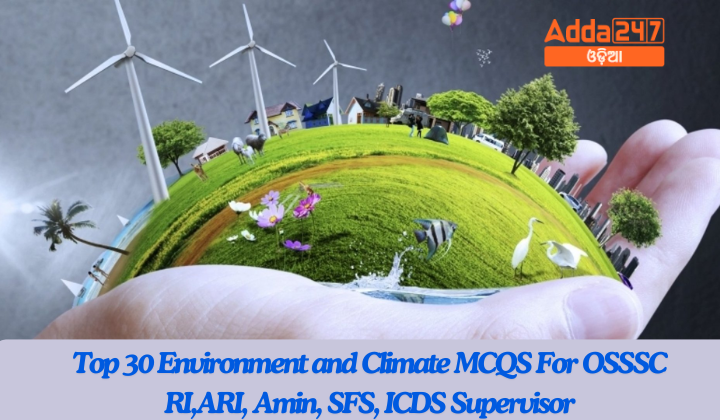Preparing for competitive exams like OSSSC RI, ARI, Amin, SFS, and ICDS Supervisor often requires a strong understanding of various subjects, including Environment and Climate. Here are 30 multiple-choice questions (MCQs) to help you prepare effectively.
Top 30 Environment and Climate MCQS For OSSSC RI,ARI, Amin, SFS, ICDS Supervisor
- The Manas National Park, a UNESCO World Heritage site, is located in which state?
[A] West Bengal
[B] Assam
[C] Karnataka
[D] Madhya Pradesh
Answer: B [Assam] - Which tribe celebrates the ‘Sarhul’ festival, marking the beginning of the new year and the sowing season by planting trees?
[A] Bhil
[B] Santhal
[C] Munda
[D] Oraon
Answer: B [Santhal] - Which among the following is NOT a biodiversity hotspot?
[A] Indo-Burma
[B] Eastern Himalaya
[C] Western Ghats
[D] Deccan Plateau
Answer: D [Deccan Plateau] - Which of the following correctly states the function of buffer zones in protected areas?
[A] They allow some human activity to reduce pressure on core zones
[B] They prohibit all human activities
[C] They serve as areas for reintroducing species
[D] None of the above
Answer: A [They allow some human activity to reduce pressure on core zones] - Which among the following is a term used for a conservation status denoting a high risk of extinction in the wild?
[A] Least Concern
[B] Near Threatened
[C] Vulnerable
[D] Critically Endangered
Answer: D [Critically Endangered] - Which of the following is the largest greenhouse gas contributor?
[A] Carbon Dioxide
[B] Methane
[C] Nitrous Oxide
[D] Water Vapor
Answer: A [Carbon Dioxide] - The Ramsar Convention is related to the conservation of which of the following?
[A] Forests
[B] Wetlands
[C] Oceans
[D] Mountains
Answer: B [Wetlands] - Which tiger reserve in India is known for the successful conservation of the Bengal Tiger population?
[A] Bandipur Tiger Reserve
[B] Periyar Tiger Reserve
[C] Ranthambore Tiger Reserve
[D] Sundarbans Tiger Reserve
Answer: C [Ranthambore Tiger Reserve] - The Bharat Mala project is related to which of the following?
[A] Highway development
[B] Waterway development
[C] Railway modernization
[D] Port development
Answer: A [Highway development] - In which state is the Silent Valley National Park, known for its rich biodiversity and pristine environment, located?
[A] Tamil Nadu
[B] Kerala
[C] Karnataka
[D] Andhra Pradesh
Answer: B [Kerala] - Which of the following states is home to the maximum number of tiger reserves in India?
[A] Madhya Pradesh
[B] Karnataka
[C] Maharashtra
[D] Tamil Nadu
Answer: A [Madhya Pradesh] - The Sundarbans National Park, famous for its mangrove forests, is located in which state?
[A] Odisha
[B] West Bengal
[C] Andhra Pradesh
[D] Kerala
Answer: B [West Bengal] - Which national park in India is renowned for its population of snow leopards?
[A] Dachigam National Park
[B] Hemis National Park
[C] Valley of Flowers National Park
[D] Kaziranga National Park
Answer: B [Hemis National Park] - The Great Himalayan National Park, a UNESCO World Heritage site, is located in which state?
[A] Uttarakhand
[B] Himachal Pradesh
[C] Sikkim
[D] Jammu and Kashmir
Answer: B [Himachal Pradesh] - Sagar Mala project is related to which of the following?
[A] Modernization of ports
[B] Oil extraction
[C] Roads development
[D] None of the above
Answer: A [Modernization of ports]
Which of the following national parks is known for being a habitat of the Asiatic Lion?
[A] Jim Corbett National Park
[B] Kaziranga National Park
[C] Gir National Park
[D] Ranthambore National Park
Answer: C [Gir National Park]
Which of the following states has the highest number of national parks in India?
[A] Madhya Pradesh
[B] Karnataka
[C] Uttarakhand
[D] Assam
Answer: A [Madhya Pradesh] - The Jim Corbett National Park, the oldest national park in India, is located in which state?
[A] Uttar Pradesh
[B] Uttarakhand
[C] Himachal Pradesh
[D] Madhya Pradesh
Answer: B [Uttarakhand] - Which national park in India is famous for its population of one-horned rhinoceroses?
[A] Bandhavgarh National Park
[B] Kaziranga National Park
[C] Periyar National Park
[D] Ranthambore National Park
Answer: B [Kaziranga National Park] - The Valley of Flowers National Park, known for its endemic flora, is located in which Indian state?
[A] Himachal Pradesh
[B] Uttarakhand
[C] Sikkim
[D] Jammu and Kashmir
Answer: B [Uttarakhand] - Most of India’s rainfall is:
[A] Cyclonic
[B] Convectional
[C] Orographic
[D] Frontal
Answer: B [Convectional] - Convectional rainfall is prevalent in which regions?
[A] Polar regions
[B] Temperate regions
[C] Equatorial regions
[D] Desert regions
Answer: C [Equatorial regions] - In an anticyclone, the wind direction in the northern hemisphere is:
[A] Clockwise
[B] Anti-clockwise
[C] Random
[D] Circular
Answer: A [Clockwise] - Which Indian islands receive rainfall from both the South-West and North-West monsoons?
[A] Lakshadweep Islands
[B] Andaman and Nicobar Islands
[C] Sri Lanka
[D] Maldives
Answer: B [Andaman and Nicobar Islands] - The following trees are associated with the dry monsoon forest of India:
[A] Pine, Fir, Spruce
[B] Mango, Mahua, Sisam, Keeker
[C] Teak, Sal, Bamboo
[D] Oak, Maple, Beech
Answer: B [Mango, Mahua, Sisam, Keeker] - Paddy fields in India are typically located in areas with annual rainfall of:
[A] Less than 50 cm
[B] 50-100 cm
[C] More than 100 cm
[D] Exactly 75 cm
Answer: C [More than 100 cm] - Which region of India receives the first monsoon in summer?
[A] Eastern Ghats
[B] Western Ghats
[C] Northern Plains
[D] Central Highlands
Answer: B [Western Ghats] - The northeastern hills that block the South West Monsoon winds and cause heavy rains in Assam are:
[A] Nilgiri, Anamalai, Cardamom
[B] Aravalli, Vindhya, Satpura
[C] Garo, Khasi, Jaintia
[D] Himalaya, Karakoram, Hindu Kush
Answer: C [Garo, Khasi, Jaintia] - An anticyclone is characterized by:
[A] High-pressure area with outward-moving winds
[B] Low-pressure area with inward-moving winds
[C] Rapid temperature drop
[D] Intense rainfall
Answer: A [High-pressure area with outward-moving winds] - Which of the following is NOT a characteristic of the dry monsoon forest of India?
[A] Thorny shrubs
[B] Grassland
[C] Evergreen trees
[D] Mango trees
Answer: C [Evergreen trees] - The average annual temperature of Chennai is:
[A] 22°C
[B] 24°C
[C] 26°C
[D] 28°C
Answer: C [26°C] - Which of the following regions are known for their annual rainfall exceeding 100 cm, making them suitable for paddy cultivation?
[A] Punjab and Haryana
[B] Rajasthan and Gujarat
[C] Maharashtra and Madhya Pradesh
[D] Tamil Nadu and Karnataka
Answer: A [Punjab and Haryana]










